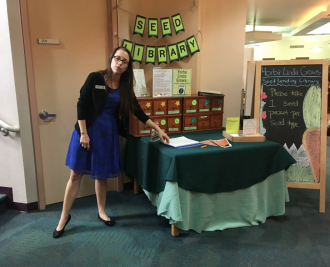Check out Seeds at the Library

A seed library enables people to get seeds for free and is run for the public benefit. Many seed libraries are located within public libraries while others are located within community centers. Dr. Daniela Soleri, an associate research scientist in the Geography Department at the University of California Santa Barbara, said seed libraries in public libraries are typically started to cultivate local cultures of sharing. As part of a study on seed libraries in California, recently published in the academic journal Agriculture and Human Values, Dr. Soleri interviewed 30 individuals who manage seed libraries in public libraries [1].
One of the librarians Dr. Soleri interviewed was Jennifer Lyon, who helps manage a seed library in the Mendocino County Library System. Lyon and other librarians from Mendocino presented at the 2017 Conference of the Association for Rural and Small Libraries on how to start a seed library. In their presentation, the librarians noted that:
“For some communities, getting folks to garden and grow some of their own food is the focus. For other communities, seed libraries may be created as an important step to develop a network of seed savers, to create locally adapted varieties, to respond proactively to climate change or loss of gene integrity due to GMOs, or to preserve genetic diversity.” [2]
Another big benefit to having seed libraries located in public libraries (as opposed to in other institutions), is that when they are in public libraries they are open longer hours. Dr. Soleri found that, on average, seed collections located in public libraries are available to the public for double the number of hours of seed collections located elsewhere. Public libraries can also connect seed libraries to health and wellness initiatives. According to the Cooperative Extension System, “Gardening is a great way to not only enjoy some fresh air, but to get some exercise and increase your physical activity, too!” [3]
Dr. Soleri did not set out to study public libraries, but she found out that most seed libraries (67%) in California are in public libraries. Most of these seed libraries are managed by library staff members who have gardening experience.

Julie Zeoli, Adult Services Librarian at the Yoruba Linda Public Library, California, and founder of Yorba Linda Grows seed library. Photo Courtesy of Daniela Soleri.
Seed libraries rely extensively on volunteer labor. They are truly a community endeavor. Dr. Soleri found that, on average, about 75 percent of the work done to manage seed libraries in public libraries was unpaid, and 27 percent of the public library seed libraries studied are managed entirely by volunteers. Furthermore, the library staff members responsible for managing seed libraries occupy diverse roles. Dr. Soleri found everyone from head librarians to part time technicians are responsible for the seed libraries.
Seed libraries acquire new seeds every year from local and national networks. The libraries then distribute those seeds. Most libraries reported acquiring their seeds from special purpose or mission-driven seed companies, either as donations or as purchases.
Dr. Soleri also found public libraries confronting challenges as they manage seed libraries. One public library staff member reported shutting down their seed library after a year and a half because borrowers never returned seed. However, other library staff report that the goal of seed libraries is not to save seed from year to year, but rather to promote access to gardening. Only 10 percent of seed libraries located in public libraries require having a library card to use the seed libraries, suggesting that this unique example of a “library of things” operates differently from the regular circulating collection.
To learn more about how to start a seed library at your public library, visit this collection of resources.
References
[1] Soleri, Daniela. “Civic seeds: new institutions for seed systems and communities—a 2016 survey of California seed libraries.” Agriculture and Human Values (2017): 1-17.
[2] Lyon, Jennifer and Roseanne Wetzel. “How to start a seed library.” A presentation at the 2017 meeting of the Association for Rural and Small Libraries, St. George, Utah, Sept. 7-9.
[3] Cooperative Extension System. “Does gardening count as exercise and physical activity?” Nov. 14, 2012. http://articles.extension.org/pages/27727/does-gardening-count-as-exercise-and-physical-activity.
Resources
Peterson, Jennifer. “Growing Library Gardening Programs.” WebJunction. http://www.webjunction.org/news/webjunction/growing-library-garden-programs.html.
Tags: ARSL, Association for Rural and Small Libraries, seed libraries, unique library collections












